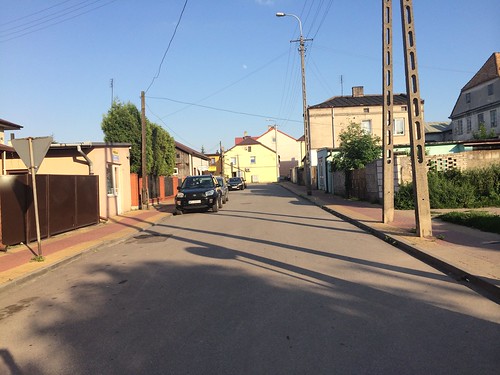Ewa was keen - to put it mildly - to find out anything we could about her grandmother, and about her own mother Laja, and this document is a mine of information. As is often the case, it raises as many questions as it answers. Here's a brief outline of what we found out from the form.
In the document, issued in the town of Gombin (Gabin), Chawa is named as Chawa Florkiewicz, née Frenkensztejn. She is a widow. This in itself was new information for Ewa, as it implies that her grandfather Elias had died by 1935; she had known nothing of him apart from his name.
My great-grandparents
Chawa's parents are shown as Jankiel Josek and Gitla née Kon. This was the first documentary confirmation we had found of the names of our great-grandparents, and an indication of a family name - Kon - we had not been aware of.
Chawa's birth-date
Chawa is shown as born on 1 January 1891. I am always somewhat suspicious of birth dates from this period that appear as '1 January' or '31 December' - or other first and last dates - as births were sometimes not registered until weeks or months - sometimes years - afterwards. The parents may not have noted the exact day of the birth at the time, and just declared a convenient date for the registration. We don't have any other documentation for her at the moment, so we'll have to accept it until we do.
Juliszew - our ancestral home?
Chawa was born in Juliszew, a place Ewa and I had not heard of. We eventually located it on the map - a small village about 12km to the East of the town of Gombin, which is where we thought they all came from. We were so excited to have discovered what we took to be the family's ancestral home! However, when I mentioned this later to Bracha, and our American cousins, they all said, "Ah yes, Yoolashov, my Dad/Grandad/whoever mentioned that place". Nevertheless, this is our first documentary evidence.
Tylna 4
Other entries on the form show Chawa as a 'worker', Jewish, and of Polish nationality. She lives at 4 Tylna Street, which is the return address she put on the envelope containing the letter to her brother. She has lived in Gombin since 1915; before that, she lived in Juliszew.
Tylna Street now. The street is quite short, but there doesn't seem to be a number 4, and we couldn't work out where it would have stood.
The household
The lower part of the document lists the members of the household. Chawa is living with 4 children, which corresponds with what Ewa had heard from her mother. Her mother Gitla does not appear to be living with her, although she was with her a year later (see the letter to Lajzer). The children were all born in Gombin: Marjem born 1915, Laja (Ewa's mother) 1917, Szejva 1919, and the only boy, Jakub Josek, 1921. We noted that Jakub Josek appeared to be named after Chawa's father, Jankiel Josek - Jankiel is a diminutive form of Jakub. The tradition among Ashkenazi Jews was to name children after recently deceased close relatives, and not after those still living, so this suggests that Jankiel Josek had died by 1921.
What we have learned
We can conclude from the form that Chawa was almost certainly living with her parents in Juliszew until she married in 1915, at the age of 24. She and her husband then moved to Gombin, and raised their family there. Her husband died at some point between 1921 and 1935. Her father had also died, before 1921, leaving her mother Gitla on her own, though we think that Chawa's sister Chaia was probably living with her for some of that time. We can surmise from the letter to Lajzer, written a year later, that Gitla fell ill around 1935, when she would have been in her mid-70s, and came to live with Chawa.
Laja's birth-date
The big surprise to us was Laja's date of birth. Ewa had always understood from her mother that she had been born in 1921. This document puts her 4 years earlier. Another date puzzle!
Laja Florkiewicz, in the centre of the group of members of Hashomer Hatzair, a socialist-zionist youth group, 1934
Then I came across this photo, in the Gombin section of Ada Holcman's web site Zchor (Remember!). The young woman in the middle is named as Lea Florkewicz, and Ewa confirms that it is indeed her mother. The young man to her left is Meir Holcman, Ada Holcman's father. The year is 1934. What do you think? Is Lea 13 in this photo, or 17? Was she born in 1921, or in 1917?
The question is, why did she later - after the War - claim a birth date of 1921? On my trip to Poland in June I came across a couple of documents that take Laja's story a little further; I'll discuss them in a later post.
Laja was one of the few young people in this photo who did not perish in the Holocaust. She was the only member of her family to survive.



No comments:
Post a Comment